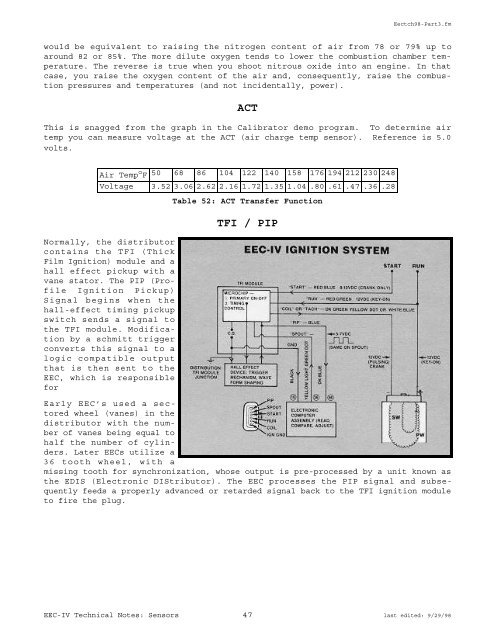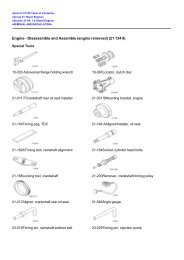TECHNICAL NOTES ON THE EEC-IV MCU - Auto diagnostics
TECHNICAL NOTES ON THE EEC-IV MCU - Auto diagnostics
TECHNICAL NOTES ON THE EEC-IV MCU - Auto diagnostics
Create successful ePaper yourself
Turn your PDF publications into a flip-book with our unique Google optimized e-Paper software.
Eectch98-Part3.fm<br />
would be equivalent to raising the nitrogen content of air from 78 or 79% up to<br />
around 82 or 85%. The more dilute oxygen tends to lower the combustion chamber temperature.<br />
The reverse is true when you shoot nitrous oxide into an engine. In that<br />
case, you raise the oxygen content of the air and, consequently, raise the combustion<br />
pressures and temperatures (and not incidentally, power).<br />
ACT<br />
This is snagged from the graph in the Calibrator demo program. To determine air<br />
temp you can measure voltage at the ACT (air charge temp sensor). Reference is 5.0<br />
volts.<br />
Air Temp o F 50 68 86 104 122 140 158 176 194 212 230 248<br />
Voltage 3.52 3.06 2.62 2.16 1.72 1.35 1.04 .80 .61 .47 .36 .28<br />
Normally, the distributor<br />
contains the TFI (Thick<br />
Film Ignition) module and a<br />
hall effect pickup with a<br />
vane stator. The PIP (Profile<br />
Ignition Pickup)<br />
Signal begins when the<br />
hall-effect timing pickup<br />
switch sends a signal to<br />
the TFI module. Modification<br />
by a schmitt trigger<br />
converts this signal to a<br />
logic compatible output<br />
that is then sent to the<br />
<strong>EEC</strong>, which is responsible<br />
for<br />
Table 52: ACT Transfer Function<br />
TFI / PIP<br />
Early <strong>EEC</strong>’s used a sectored<br />
wheel (vanes) in the<br />
distributor with the number<br />
of vanes being equal to<br />
half the number of cylinders.<br />
Later <strong>EEC</strong>s utilize a<br />
36 tooth wheel, with a<br />
missing tooth for synchronization, whose output is pre-processed by a unit known as<br />
the EDIS (Electronic DIStributor). The <strong>EEC</strong> processes the PIP signal and subsequently<br />
feeds a properly advanced or retarded signal back to the TFI ignition module<br />
to fire the plug.<br />
<strong>EEC</strong>-<strong>IV</strong> Technical Notes: Sensors 47 last edited: 9/29/98




